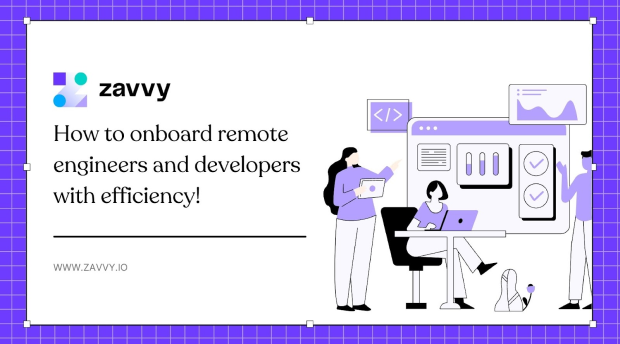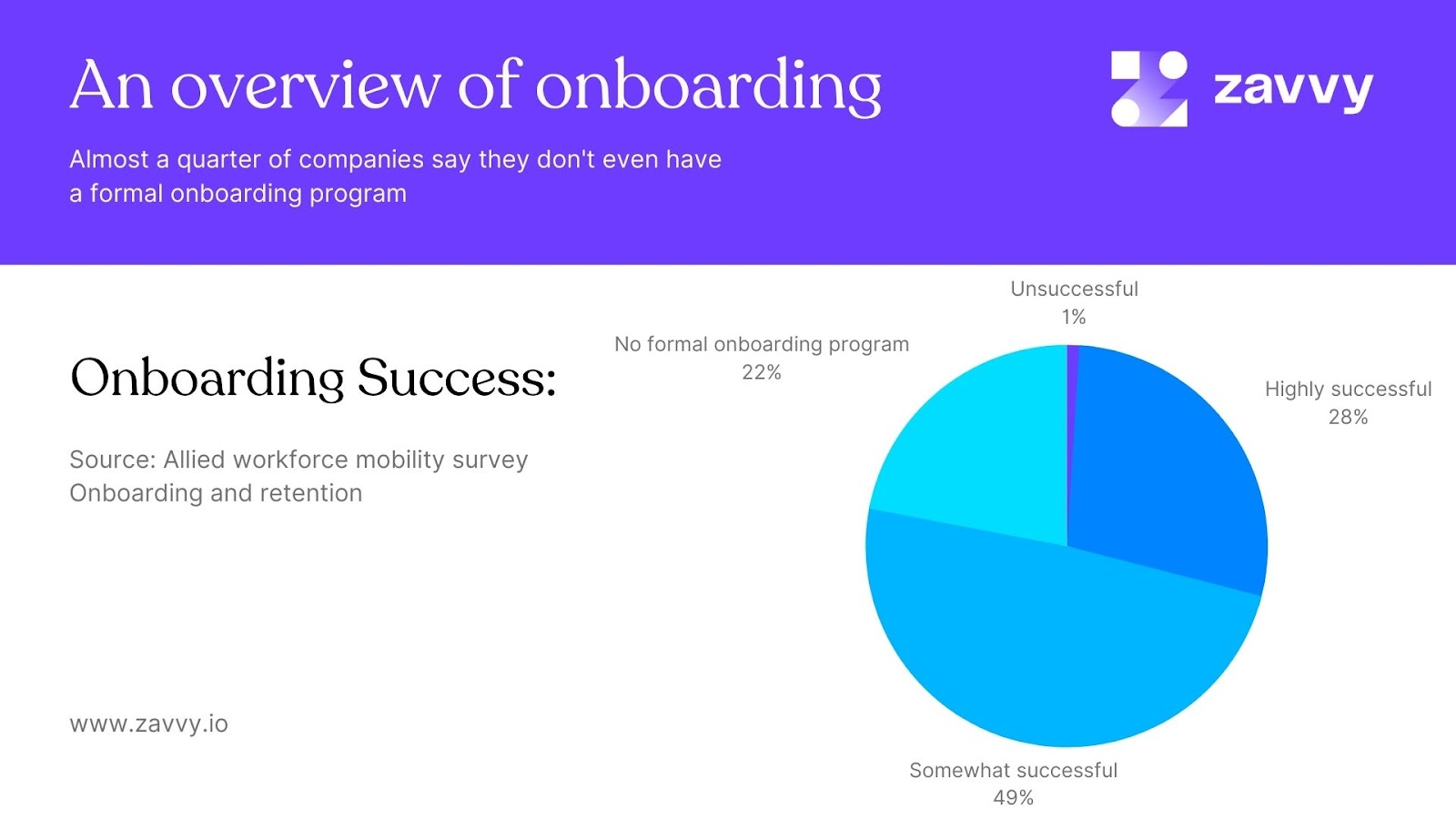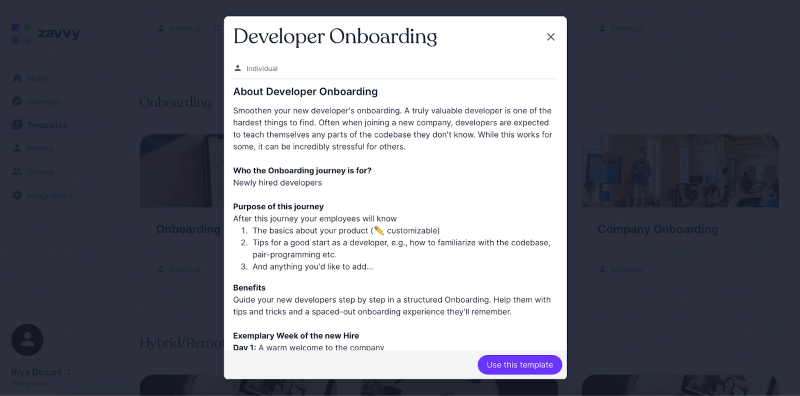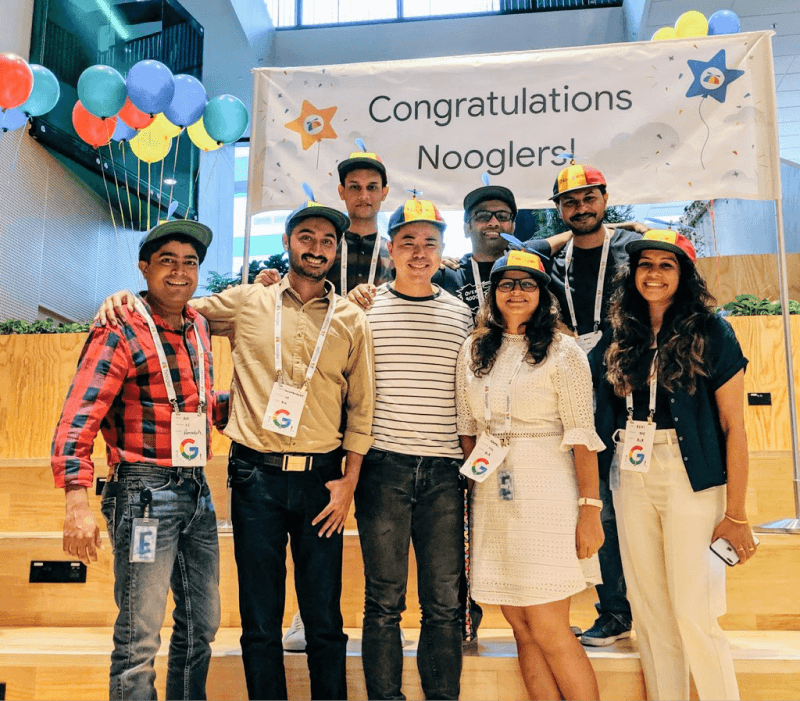
Alexander Heinle
Alex is a marketer at Zavvy. On this blog, he mainly shares insights gained from discussions with selected experts and from helping our customers set up and improve their onboarding or learning programs.


Hiring the best engineers and developers for your organization is only half the battle—you also want the new employees to stay productive and satisfied to build an effective, thriving team.
Easier said than done, though.
Many companies lose 25% of their employees in the first year, and the ones that stay aren’t fully productive for the first eight months of employment. If you don’t want to be a part of this statistic, you need an effective system for onboarding developers/engineers.
Together with our curators, we have created a library of actionable digital marketing resources. Personalized to your team's needs.
Onboarding developers and engineers involves bringing the new employees to a point they’re working at full capacity and are fully integrated into the organization.
With a successful onboarding process in place, you can:
On the other hand, inadequate onboarding leads to undertrained and disoriented new hires. The strain of their constant questions slows down (and annoys) more experienced team members, leading to a cumulative dip in team productivity and efficiency.
Despite the consequences, 22% of companies still have no formal onboarding process. And if they do, over 49% of them haven’t been able to implement it successfully.

Onboarding is really the first opportunity you have to set up new employees for long-term success.
While developers and engineers have deep technical knowledge, starting a new job can be challenging for them. Learning names and faces, unraveling a mountain of code, understanding new work processes and technical systems… there’s so much software that they have to do.
Onboarding remote engineers has become trickier after the pandemic. Throughout 2020, companies struggled with remote hiring and onboarding, mostly because they didn’t have the muscle for remote communication.
Thankfully, this precedent is rapidly shifting, with organizations embracing new technologies for hiring, onboarding, and training models.
Retaining the talent you brought in and developing a fruitful working relationship are the other benefits. 69% of employees are more likely to stay with a company for three years if they experienced great onboarding. The fact that replacing a developer can cost you anywhere from 30-50% of an employee’s salary makes investing time and effort in creating an effective onboarding process cost-effective, too.

The hiring status quo for corporate onboarding looks like this: a stack of forms to complete, a brief rundown of the company’s history and policies, getting introduced to a few colleagues, and a quick session with IT to set up email and other user accounts.
In the case of engineers and developers, an additional step is added where they get a checklist of links to read with instructions to work through it.
This is still a failing approach to developer onboarding.
Developer onboarding is the practice of imparting your organization’s expectations—technical, process, product, and professional—in a way that makes all the information usable and actionable to the new hire.
In this piece titled A Poor Developer Onboarding Experience Can Kill Your Startup, Shawn Reisner calls developer onboarding “organizational socialization”, because there’s so much more to it than simply learning the tech stack. He emphasizes how you also want your new employees to feel valued and secure in asking questions.
How do you do that?
A successful engineer and developer onboarding program should cover four critical areas:
If your program doesn’t cover all four areas, the new hire might end up taking months to get up to speed with your organization.
You have to properly understand your software engineers’ needs and facilitate the entire onboarding process around the challenges they face. Remember, the skill sets are completely different here, which is why eliminating hesitations to ask for help and removing communication barriers is equally important.
When compared to other corporate employees, software engineers and developers desire more streamlined efficiency and automation, as well as clear-cut documentation, that can help them to ramp up work and take ownership for their part faster.
Effective onboarding is critical to make your new software engineers and developers productive, loyal, and engaged employees. It comprises three comprehensive stages, which we've discussed in detail below:
First up, you want the engineer to know your company and understand your product and their role.
This stage will span over a few days or months, depending on your company size. Here are some guidelines:
On the first day for SMBs, and within the first three days for large enterprises.
Within the first two days for SMBs, and the first five days for large enterprises.
Within the first three days for SMBs and the first week for large enterprises.

New software engineers need to learn how to get the code to the customers, leverage current systems and technologies that exist within your company, and become team players. You also don’t want them to waste time on things that have already been done or defined in the past.
Again, the timelines to ramp up coding will differ based on your company size. Let’s take a quick look at how to go about things at this stage.
If you’re a SMB, you can start putting a new engineer on call within the first month, especially when your company practices the You Built It You Release It (YBIYRI) model.
On the other hand, the waiting period is longer for large enterprises. It’s recommended to put new developers on-call after they’ve shadowed an on-call rotation, which can be months.
A new software engineer can drive team activities after they’ve seen them being done at least two times. This applies to both SMBs and large enterprises.
Within the first 15 days for SMBs, and within two months for large enterprises.
Within the first week for startups and within the first three weeks for large enterprises.
In about three months for SMBs, and six months for large enterprises.
New startup employees can participate in guilds and charters like Frontend Guild and Technical Architecture Guild in a month, while large enterprise employees can participate in about three months.
This onboarding stage is every new software engineer and developer's comfort zone, where they do what they do best: coding. The fact that you hired them means you’re confident about their technical capabilities for the role, so you can sit back and relax (well, kind of).
Here’s how you can go about it:
On the first day for SMBs and within the first two weeks for large enterprises.
Within the first three days for SMBs, and within the first fortnight for large enterprises?
While software engineers working at a SMB can expect to see their work live within the first ten days, the release cycle for large enterprises hires is generally after the first month.
In the first week for SMBs and the first month for large enterprises.
After the first sprint for SMBs (two weeks) and after two sprints for large enterprises (four weeks).
Within the first sprint, which means two weeks for SMBs, and within the first month for large enterprises.
Note: All the above timeframes are just estimations. Each workforce has unique employees, having their own processes and learning capabilities.
Onboarding for software engineers doesn’t have to be complicated—all you need is the right guidance. The ultimate goal of onboarding developers and engineers is to help them become productive as quickly as possible.
Here’s a step-by-step rundown of a successful engineer onboarding process to help you avoid any missteps:
The first step is to familiarize your new software engineer with your company, including the company culture, their colleagues, and the tools they’ll be using.
Your new employees should know what project they’ll be working on and where it’s going. Give them the answers to the following questions to get them up to speed:
Knowing the above will make developers and engineers more confident about the project.
Introduce the new hires to the rest of the team. You don’t have to make it overly formal—keep it simple and personal.
Here’s how to go about it:

Next, you want your new software developers and engineers to ease into the actual workflow and start ramping up production. To do this right, you need to ensure they have everything they need to start working, like:
Of course, you only need to do the above as and when the need arises. It's better to spend some extra time giving employees access later than risk getting them overwhelmed right away.
This is where things get more specific.
New developers need technical documentation to determine the best practices and eliminate pain points related to your project. Otherwise, they won’t have a frame of reference to appraise it effectively.
Having worked with companies with large software engineering teams, we found the following data are most important for the successful onboarding of developers/engineers:
Deployment is a scripted process, and developers should know each step to prevent them from breaking the existing features. Give developer notes to new developers and engineers for ongoing projects to get them up-to-date with project quirks and past mistakes.
You can optimize onboarding for software engineers further—all you have to do is ask yourself a couple of questions before the first day of onboarding:
If you have answers to all the above questions, you’re already on your way to onboarding a new team member successfully. But you can make the process more streamlined by implementing the following onboarding best practices:
Preboarding is all about providing the new hires with everything they need—access to systems, making introductions, and setting company expectations—to feel comfortable on the first day of the job.
First and foremost, you want the developer to understand your company culture. Share your digital employee handbook and show them presentations and videos that highlight your company values, mission, and vision.
Although optional, a welcome package will make a good addition to your engineer onboarding checklist. This can include:
Next, help them with the HR paperwork and work out logistics. Be sure to get the technical stuff out of the way beforehand by providing them access to the company’s project management systems, chat apps, email, and learning management systems.
You can leverage a range of communication and project management tools to onboard developers remotely.
For example, Slack and Basecamp help foster easy collaboration and ensure seamless communication. Another tool we highly recommend for remote developers is Codeshare and GitLab. Your team members can use them to share code in real-time.
Invest in all the necessary tools that let remote developers have the same level of discussions as they would have if they were on-site. Also, give them enough time to learn how to use the tools and software. Be patient and accommodating.
Onboarding automation lets you guide your new software engineers and developers throughout onboarding without any manual effort.
Below are a few ideas to use automation in your engineer onboarding processes as recommended by the SHRM:
With a simple one-time setup for common processes like training new employees, connecting them with mentors and buddies, and sending reminders, you can help your HR department save time and give recruits a personalized welcome. Automation also makes the onboarding process more streamlined, reducing costs and boosting productivity.

For instance, when you onboard developers with Zavvy’s templates, you can automate:
Over 87% of organizations believe assigning a mentorship or buddy program during the onboarding process helps speed up new-hire proficiency. This makes sense because every new hire is guaranteed to have someone they can go to with questions or ask for help if they aren’t comfortable talking about it to their manager.
How to implement a buddy program? Choose a seasoned employee to greet and orient a new developer and check on them weekly for the first month and then one or two times thereafter. To ensure your new hire is acclimating to the new workspace effectively, you can request an assigned ‘buddy’ to:
A buddy or mentor‘s primary duty is to make the new employees feel comfortable right away. In turn, this will encourage the latter to start contributing to ongoing projects quickly.
Zapier, for instance, has a ‘Zap Pal‘ program, where every new hire is assigned a Zap Pal, who:
This 1:1 relationship facilitates smoother onboarding and instills confidence in the new hire.

Pair programming is a popular software development practice where two programmers work together—one writes the actual code while the other reviews each line as it’s written.
You can have the newly hired developers work on the same code together in real-time, giving them the chance to discuss decisions and share feedback. This can be done on a video call via screen sharing or on-site, depending on how your team operates.
Pair programming is particularly useful during the onboarding process of new engineers. Not only does it help them get acclimatized to your company processes easily, but it also leads to more efficient code. Additionally, it serves as cross-training that sets free knowledge from the silos of experience that typically exists in a team.

Google’s onboarding process is as exemplary as the company itself. Driven by the motive to help new engineers to achieve their full potential, they created NEHEN aka “Noogler Engineers Helping Engineering Nooglers.”
Founded on the insight that newcomers are afraid to ask ‘stupid questions’, this two-week program takes engineers through the organizational structure, core technologies and programming practices. Senior engineers deliver live lectures on Google practices and culture during which they share the “engineering perspective” and answer questions of every newcomer.
Google engineers are usually organized in small teams that create opportunities for collaboration, and networking between new hires and, or established team members. An internal tool called “MOMA” is used to share information on how to be a productive engineer at Google.
For engineers, a large part of the orientation process comprises familiarizing with the knowledge base created by the engineering department. It consists of sections dedicated to individual engineers, virtual institutions, and job-specific courses.
To help new engineers acclimatize with new technology, Nooglers attend hands-on tutorials called Codelabs to get up to speed. However, this is just not limited to newcomers. Experienced engineers can also benefit from these tutorials to stay updated with the newest technology and softwares.
On completion of the Noogler program, employees send weekly snippets of their progress, and projects they’ve been working on. At the end of every quarter, they participate in self-assessments called Objectives and Key Results.
Every Noogler is encouraged to set measurable goals during this orientation period. While it may sound daunting at the time, the goal is to achieve 70% of their target.
Great onboarding will let you use your resources to their full potential. You’ll finally see the full capabilities of your new staff while reducing turnover and boosting productivity.
While there’s no cookie-cutter onboarding system that you can apply right off the bat, we hope our guidelines and best practices will help you make your own customized to your organization’s exact requirements.
Want to make onboarding easier? Use our onboarding software to automate the busywork and allow your new hires to get up to speed faster and more effectively. With Zavvy, you can remove the friction of developer onboarding and help engineering teams build the best products.
It also has TONS of fun integrations, and you already know just how much engineers love that. Connect with our experts for a free consultation!
Upskill your team every week with the best contents and personalized recommendations.

Hiring the best engineers and developers for your organization is only half the battle—you also want the new employees to stay productive and satisfied to build an effective, thriving team.
Easier said than done, though.
Many companies lose 25% of their employees in the first year, and the ones that stay aren’t fully productive for the first eight months of employment. If you don’t want to be a part of this statistic, you need an effective system for onboarding developers/engineers.
Get a demo!
We'll be happy to show you around and answer all your questions.
Trusted by innovative companies



We'll be happy to show you around, answer your questions, or arrange a free trial.
Erhalten Sie eine kostenlose Demo unserer Onboarding-Software.
Vertraut von



Your Training & Development Strategy - Solved in 1 Tool.
Trusted by innovative companies



We'll be happy to show you around, answer your questions, or arrange a free trial.
Learn how Zavvy helps you drive performance, development, and engagement.
Trusted by innovative companies



We'll be happy to show you around, answer your questions, or arrange a free trial.
We'll be happy to show you around and answer all your questions.
Trusted by innovative companies



We'll be happy to show you around, answer your questions, or arrange a free trial.
Gerne zeigen wir Ihnen ganz unverbindlich unsere Plattform im Detail.
Vertraut von modernen Unternehmen



Get a demo!
We'll be happy to show you around and answer all your questions.
Trusted by innovative companies



We'll be happy to show you around, answer your questions, or arrange a free trial.
Erhalten Sie eine kostenlose Demo unserer Software für Mitarbeiterenwicklung und Training.
Moderne Unternehmen
setzen auf Zavvy


